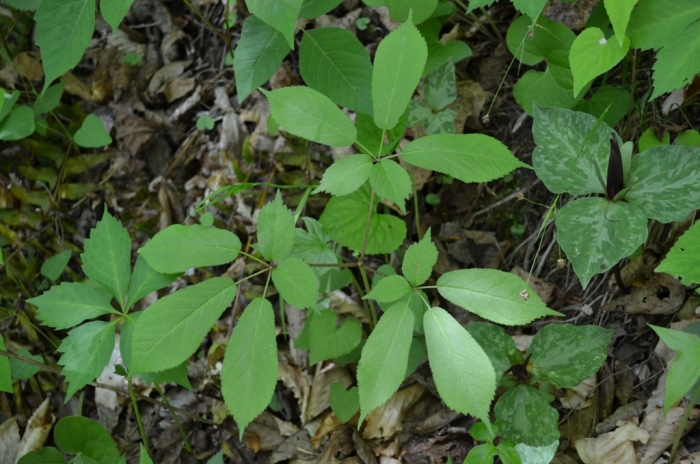American Ginseng
(Panax quinquefolius)
American Ginseng (Panax quinquefolius)
/
/

© Evan M. Raskin
CC BY 4.0
Image By:
© Evan M. Raskin
Recorded By:
Copyright:
CC BY 4.0
Copyright Notice:
Photo by: © Evan M. Raskin | License Type: CC BY 4.0 | License URL: http://creativecommons.org/licenses/by/4.0/ | Uploader: eraskin | Publisher: iNaturalist |

























Estimated Native Range
Summary
Panax quinquefolius, commonly known as American ginseng, is a slow-growing perennial herb native to the deciduous forests of eastern North America, including the Appalachian and Ozark regions. It is not naturally found in China, though it has been introduced there. This plant typically grows 6-18 inches tall and is characterized by its forked, aromatic root, which resembles a small parsnip. The leaves are palmately compound with three to five leaflets, and the plant produces inconspicuous greenish-yellow flowers in the summer. By early September, the flowers give way to bright red berries.
American ginseng is renowned for its medicinal properties, particularly in traditional Chinese medicine, where it is used for its reputed cooling and sedative effects. The roots are the most valuable part and are harvested for this purpose. In cultivation, ginseng requires a shaded environment, mimicking its natural forest floor habitat, and well-drained, rich soils. It is often grown under artificial shade structures to replicate these conditions. Due to its specific growing requirements and slow growth rate, ginseng can be a challenging plant for gardeners. Overharvesting in the wild and habitat destruction have led to its vulnerability, resulting in its inclusion in Appendix II of CITES and being considered endangered in Canada. Gardeners interested in cultivating ginseng should be aware of its conservation status and obtain plants from reputable sources that cultivate them sustainably.CC BY-SA 4.0
American ginseng is renowned for its medicinal properties, particularly in traditional Chinese medicine, where it is used for its reputed cooling and sedative effects. The roots are the most valuable part and are harvested for this purpose. In cultivation, ginseng requires a shaded environment, mimicking its natural forest floor habitat, and well-drained, rich soils. It is often grown under artificial shade structures to replicate these conditions. Due to its specific growing requirements and slow growth rate, ginseng can be a challenging plant for gardeners. Overharvesting in the wild and habitat destruction have led to its vulnerability, resulting in its inclusion in Appendix II of CITES and being considered endangered in Canada. Gardeners interested in cultivating ginseng should be aware of its conservation status and obtain plants from reputable sources that cultivate them sustainably.CC BY-SA 4.0
Plant Description
- Plant Type: Herb
- Height: 0.6-2 feet
- Width: 0.6-1 feet
- Growth Rate: Slow
- Flower Color: White, Yellow
- Flowering Season: Spring, Summer
- Leaf Retention: Deciduous
Growth Requirements
- Sun: Part Shade, Full Shade
- Water: Medium
- Drainage: Medium
Common Uses
Edible*Disclaimer: Easyscape's listed plant edibility is for informational use. Always verify the safety and proper identification of any plant before consumption., Low Maintenance
Natural Habitat
Native to deciduous forests of eastern North America, particularly the Appalachian and Ozark regions
Other Names
Common Names: Xi yang shen, Ginseng, Occidental Ginseng, Sang, Sheng, Five-leaf Ginseng
Scientific Names: , Panax quinquefolius, Aralia quinquefolia, Aureliana canadensis, Ginseng quinquefolium, Panax americanus, Panax americanus var. elatus, Panax americanus var. obovatus, Panax cuneatus, Panax obovatus
GBIF Accepted Name: